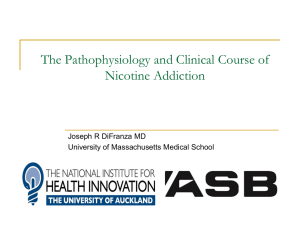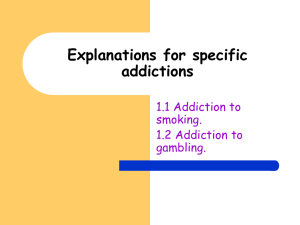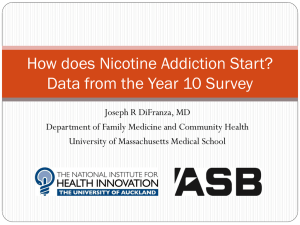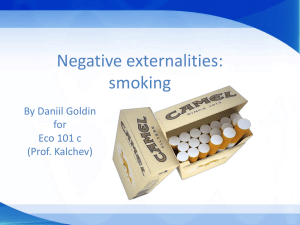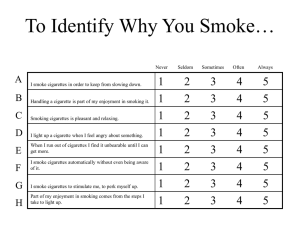So you think you are a social smoker
advertisement
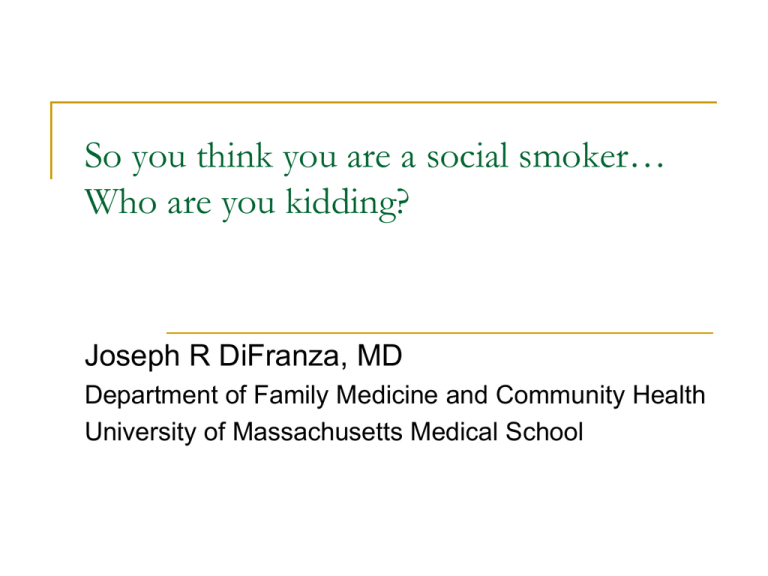
So you think you are a social smoker… Who are you kidding? Joseph R DiFranza, MD Department of Family Medicine and Community Health University of Massachusetts Medical School What is a social smoker? Fewer than 5 cigarettes per day May not smoke everyday No symptoms of addiction The girl who didn’t read the text book Addiction From addictus, meaning assigned A Roman magistrate would assign the loser to perform work or pay a forfeit to the victor. Addiction does not mean self-destruction, it means an obligation, a loss of autonomy. The Loss of Autonomy When quitting requires an effort or involves discomfort The Hooked on Nicotine Checklist Hooked on Nicotine Checklist 1) Have you ever tried to quit, but couldn’t? 2) Do you smoke now because it is really hard to quit? 3) Have you ever felt like you were addicted to tobacco? Hooked on Nicotine Checklist 4) Do you ever have strong cravings to smoke? 5) Have you ever felt like you really needed a cigarette? 6) Is it hard to keep from smoking in places where you are not supposed to? Hooked on Nicotine Checklist When you haven't smoked for a while do you… 7) find it hard to concentrate? 8) feel more irritable? 9) feel a strong need or urge to smoke? 10) feel nervous, restless or anxious? Prospective study of adolescents 25% had lost autonomy within 30 days 25% had lost autonomy by the time they were smoking 1 cigarette/month 10% had lost autonomy within 2 days Students were smoking an average of 2 cigarettes/week when addiction started. Percent with Diminished Autonomy 100 90 80 70 60 Girls 50 Boys 40 30 20 10 0 1 2 3-4 5-9 10 - 19 20 - 99 Lifetime Cigarette Consumption ≥ 100 Loss of Autonomy 100 90 80 Percent 70 60 50 40 30 20 10 0 Less than monthly Monthly Weekly Frequency of Smoking Daily The clinical data indicate that… One cigarette must rapidly change the brain. The neuroscience shows… The nicotine from one cigarette occupies 88% of the brain’s nicotinic receptors. One dose of nicotine triggers the transcription of at least 168 genes in the brain. One dose stimulates an increase in the number of brain nicotine receptors over night. One dose initiates drug sensitization. % Change in Distance Travelled (% of Day 1) Nicotine-Induced Behavioral Sensitization 900 850 800 750 700 Average of Nicotine animals (n=4) Average of Control animals (n=4) 650 600 550 500 450 400 350 300 250 200 150 100 50 1 2 3 Day 4 5 6 A 1 1 5 B 2 2 2 3 3 4 4 7 5 7 6 6 5 PFC 2 Acg 3 Acc 4 VP 7 5 HP 6 VTA 7 VC 5% 4% 3% 2% 1% 0 C -1% -2% -3% -4% -5% The neuroscience shows… Four doses of nicotine are enough to increase the density of dendrites in brain regions involved in addiction. Before… 18 After … 19 The First Case Series on Nicotine Addiction In all addicted smokers withdrawal triggers a desire to smoke that compels them to use tobacco The First Case Series on Nicotine Addiction How would you describe this need to someone who has never smoked? Wanting Craving Needing Wanting Wanting is a mild transient desire to smoke that is easily ignored. “It’s like wanting some chocolate.” Craving Craving is more intense than wanting and intrudes upon the person’s thoughts. It is more persistent and is difficult to ignore. “I feel like someone inside of me is really telling me to smoke.” Craving “just, like, pops in your head, like someone is sending you a message.” Craving Craving is like “being hungry, but instead of your stomach saying it, it’s your brain…it’s just hungry, except for a cigarette.” “I’ve felt, like, physical urges, like just craving them, but not like a mental thing.” Needing Needing is an intense and urgent desire to smoke that is impossible to ignore. The individual must smoke to restore a normal mental or physical state. “Pretty urgent… you need it and you can’t get your mind off it.” “You really want one. You know you need it. You know you’ll feel normal after smoking, and you have to smoke to feel normal again.” When addiction first develops No withdrawal symptoms Wanting Wanting and Craving Wanting, Craving, and Needing Clinical Staging of Nicotine Addiction Stage 1 No withdrawal symptoms Stage 2 Wanting “If I go too long without smoking the first thing I will notice is a mild desire to smoke that I can ignore.” Stage 3 Craving Smokers can remain abstinent indefinitely without withdrawal symptoms. “If I go too long without smoking, the desire for a cigarette becomes so strong that it is hard to ignore and it interrupts my thinking.” Stage 4 Needing “If I go too long without smoking, I just can’t function right, and I know I will have to smoke just to feel normal again.” Mean Adolescent HONC Scores by Stage 10 9 8 Score 7 6 5 4 3 2 1 0 Stage 1 Stage 2 Stage 3 Stage 4 Mean Adult HONC Scores by Stage 10 9 8 Score 7 6 5 4 3 2 1 0 Stage 1 Stage 2 Stage 3 Stage 4 Days Smoked per Month by Stage (adults) Days smoked per month 30 25 20 15 10 5 0 Stage 1 Stage 2 Stage 3 Stage 4 Number of Cigarettes Smoked on Smoking Days (adults) cigarettes smoked per day 14 12 10 8 6 4 2 0 Stage 1 Stage 2 Stage 3 Stage 4 The Latency to Withdrawal “A little light bulb goes off and it’s like, alright, time [to smoke].” The latency is the interval between smoking one cigarette and wanting, craving, or needing another. Latency-to-wanting Latency-to-craving Latency-to-needing The Latency to Withdrawal At the onset of addiction the latency-to-wanting may be longer than a month. Smokers do not realize they are having withdrawal symptoms. With a half of life of 2 hours in the blood, how can nicotine keep withdrawal at bay for weeks? The neuroscience shows… One dose of nicotine increases noradrenaline synthesis for at least a month. One dose lowers activation thresholds for a month. One dose affects tyrosine hydroxylase activity for a month. One dose in adolescence has measurable effects on behavior during adulthood. The Latency to Withdrawal At the onset of addiction the latency-to-wanting may be longer than a month. With repeated tobacco use tolerance develops causing the latencies to shrink. The shortening of the latency drives the escalation in tobacco use. The Latency to Withdrawal After smoking for 6 weeks, a 16-year-old girl noticed a latency-to-craving of 2 days which shortened to 4 hours by age 161/2, …to 2 hours by age 17, …to 1.5 hours by age 18, …to 1 hour by age 19, …and to 30-45 minutes by age 21. The Latency to Withdrawal-factors of 2 1) 2) 3) 4) 5) 6) 7) 8) 9) 10) 11) 12) 4 weeks 2 weeks 1 week (1 cig/wk) 3.5 days (2 cig/wk) 42 hours 21 hours 11.5 hours 5.6 hours 2.8 hours 1.4 hours 42 minutes (1 ppd) 21 minutes (2 ppd) At age 12, smoking 2 cigs/wk increases the risk for heavy adult smoking 174 fold The Vicious Cycle Tobacco use Shortening latencies Neurological adaptations Symptoms of Wanting, Craving, Needing The Blind Men and the Elephant. The Blind Men and the Elephant - John Godfrey Saxe And so these men of Indostan Disputed loud and long, Each in his own opinion Exceeding stiff and strong. Though each was partly in the right, They all were in the wrong! The committee of blind researchers describe the multiple domains of addiction. Craving Withdrawal Regularity of use Spending too much time smoking Giving up other activities in order to smoke Smoking immediately upon arising from bed Smoking more than intended Tolerance All of the so-called domains of nicotine addiction are the same elephant: Wanting, Craving and Needing and the Latency to Withdrawal. The Latency-factors of 2 1) 2) 3) 4) 5) 6) 7) 8) 9) 10) 11) 12) 4 weeks 2 weeks 1 week (1 cig/wk) 3.5 days (2 cig/wk) 42 hours 21 hours (daily smoking) 11.5 hours 5.6 hours 2.8 hours 1.4 hours 42 minutes (1 ppd) 21 minutes (2 ppd) Bums cigarettes at parties Smokes only on weekends First time buying cigarettes Smokes before work or school Smokes upon awakening Uses lunch break to smoke Smoking in the bathroom Smokes in middle of the night I am careful not to run out. I make sure I have enough cigarettes for the next morning (adults) 100 90 % Endorsed 80 70 60 50 40 30 20 10 0 Stage 1 Stage 2 Stage 3 Stage 4 % Endorsed To some degree I have to plan my schedule around when I will be able to smoke (adults) 100 90 80 70 60 50 40 30 20 10 0 Stage 1 Stage 2 Stage 3 Stage 4 How the Latencies affect smokers’ behaviors Required cigarettes and elective cigarettes How can I miss you when you won’t go away? 1) 2) 3) 4) 5) 6) 7) 8) 9) 10) 11) 12) 4 weeks 2 weeks 1 week 3.5 days 42 hours 21 hours (1 cpd) 11.5 hours 5.6 hours 2.8 hours 1.4 hours 42 minutes 21 minutes A person who starts smoking one cigarette per day will not experience withdrawal until their latency shortens to less than a day. Asymptomatic addiction Smokers are late to recognize addiction “I’m not addicted, I only smoke once a week when I feel the urge.” “I can’t be addicted because I don’t need to smoke everyday.” “I can’t be addicted because I never buy my own cigarettes.” Smokers don’t recognize their addiction until stage 3 or 4, or when the latency shortens to less than 24 hours. Nondaily smokers relapse at the same rate as daily smokers Over 90% fail at their first attempt to quit smoking. Summary The neurological changes triggered by nicotine begin with the first dose. Symptoms of a compulsion to use tobacco develop through 4 stages. The shortening of the latency to withdrawal drives the progression to daily smoking. Most social smokers are addicted and don’t know it. So you think you are a social smoker… Who are you kidding? Joseph R DiFranza, MD Department of Family Medicine and Community Health University of Massachusetts Medical School


